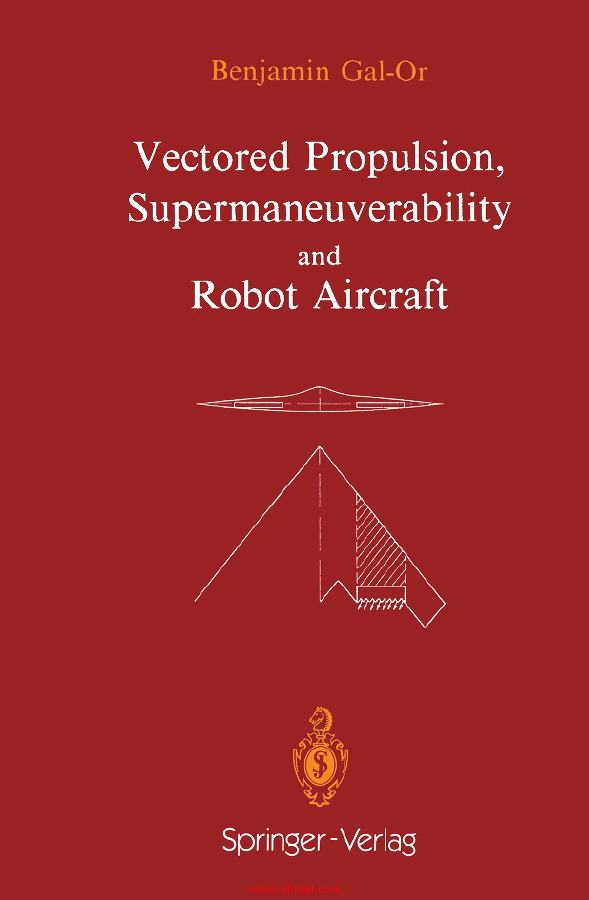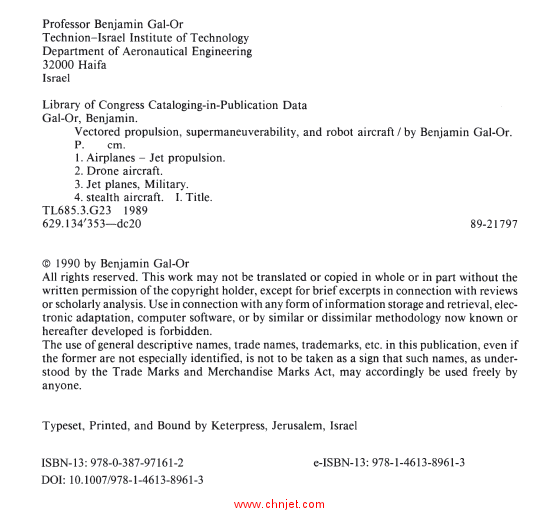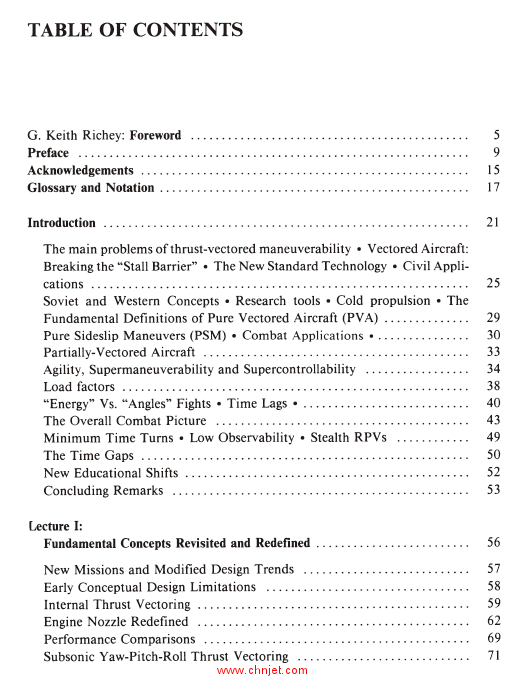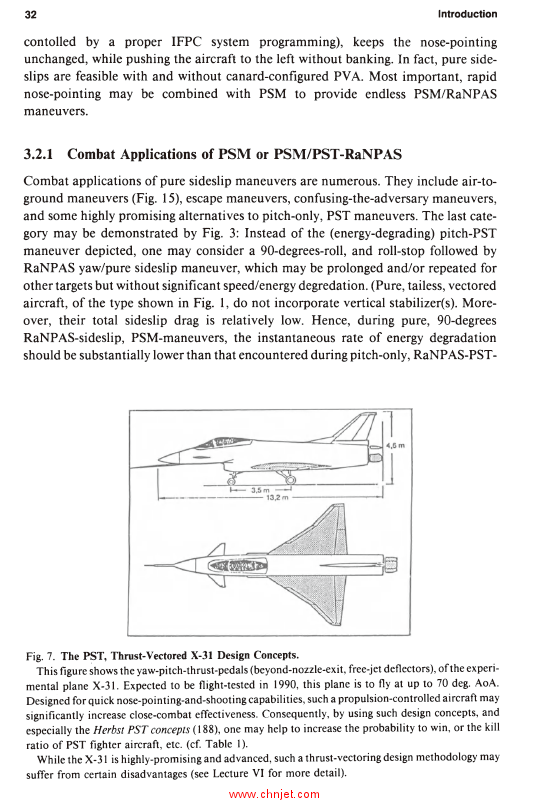马上注册,结交更多好友,享用更多功能,让你轻松玩转社区。
您需要 登录 才可以下载或查看,没有账号?立即注册

×
《Vectored Propulsion, Supermaneuverability and Robot Aircraft》
矢量推力、超机动性和机器人飞机
作者:Benjamin Gal-Or
出版社:Springer
出版时间:1990年
《Vectored Propulsion, Supermaneuverability and Robot Aircraft》

《Vectored Propulsion, Supermaneuverability and Robot Aircraft》

《Vectored Propulsion, Supermaneuverability and Robot Aircraft》

《Vectored Propulsion, Supermaneuverability and Robot Aircraft》

目录
Preface ............................................................... 9
Acknowledgements ..................................................... 15
Glossary and Notation.................................................. 17
Introduction ........................................................... 21
The main problems of thrust-vectored maneuverability • Vectored Aircraft:
Breaking the "Stall Barrier" • The New Standard Technology • Civil Applications.............................................................
25
Soviet and Western Concepts • Research tools • Cold propulsion • The
Fundamental Definitions of Pure Vectored Aircraft (PVA) .............. 29
Pure Sideslip Maneuvers (PSM) • Combat Applications • . . . . . . . . . . . . . . . 30
Partially-Vectored Aircraft ........................................... 33
Agility, Supermaneuverability and Supercontrollability ................. 34
Load factors ........................................................ 38
"Energy" Vs. "Angles" Fights • Time Lags • ........................... 40
The Overall Combat Picture ......................................... 43
Minimum Time Turns • Low Observability • Stealth RPVs ............ 49
The Time Gaps ..................................................... 50
New Educational Shifts.............................................. 52
Concluding Remarks 53
Lecture I:
Fundamental Concepts Revisited and Redefined ......................... 56
New Missions and Modified Design Trends ........................... 57
Early Conceptual Design Limitations ................................. 58
Internal Thrust Vectoring ............................................ 59
Engine Nozzle Redefined ............................................ 62
Performance Comparisons ........................................... 69
Subsonic Yaw-Pitch-Roll Thrust Vectoring ............................ 71
vii
Lecture II:
Vectored Aircraft and Supermaneuverability 78
Yaw-Pitch Vectoring and Supercirculation ............... ... ........... 78
Pure J etborne Flight Control ......................................... 81
STOL or V/STOL Vectored Aircraft .................................. 82
Dimensionless Numbers for Pure Vectored Aircraft .................... 83
Emergency Landing ................................................. 88
Air-to-Air Operations ...... . . . . . . . . . . . . . . . . . . . . . . . . . . . . . . . . . . . . . . . . . . 91
Air-to-Ground Operations. . . . . . . . . . . . . . . . . . . . . . . . . . . . . . . . . . . . . . . . . . . . 92
Propulsion and Supermaneuverability ................................. 92
Maneuver Analysis..... ..... ....................... ... ... ........ ... 95
Controllability Limits. . . . . . . . . . . . . . . . . . . . . . . . . . . . . . . . . . . . . . . . . . . . . . . . 97
High-Alpha Flight Envelopes ......................................... 102
The Non-Availability of a "Vectored Inlet" ............................ 104
Lecture III:
The Matrix of Unknown Variables of Vectored Aircraft 105
Reservations and Precautions ........................................ 106
Technology Limits .................................................. 107
Cooling Limits .. . . . . . . . . . . . . . . . . . . . . . . . . . . . . . . . . . . . . . . . . . . . . . . . . . . .. 109
Nozzle Aspect Ratio Limits .......................................... 114
Aerodynamic Effects ................................................ 115
Nozzle Coefficients Revisited ........................................ 125
Thrust Vectoring Range . . . . . . . . . . . . . . . . . . . . . . . . . . . . . . . . . . . . . . . . . . . . .. 128
Induced drag and Supercirculaton .................................... 130
Lecture IV:
Vectored Aircraft as R&D Tools, or as Super-Agile Robotic Flying Systems 133
Cruise Missiles, RPV s, etc. ........................................... 134
Expanded Missions Vs. R&D tools ................................... 136
Cost-Effectiveness of Flying Vectored RPV s ........................... 139
Synergetic Studies. . . . . . . . . . . . . . . . . . . . . . . . . . . . . . . . . . . . . . . . . . . . . . . . . .. 145
Master Plan and New Programs ...................................... 151
Scaling Consideratons ............................................... 153
Lecture V:
Partially Vectored Aircraft . . . . . . . . . . . . . . . . . . . . . . . . . . . . . . . . . . . . . . . . . . .. 155
Canard-Configured Vectored Aircraft ................................. 156
Upgrading extant Aircraft to Become Vectored Fighters - The Vectored F-15
Fighter ........................................................... 163
viii
Upgrading F-18 and F-16 Fighters.................................... 167
The Search for Design Philosophy in the Post-A TF Era .. . . . . . . . . . . . . . .. 168
Lecture VI:
The Pros and Cons of Internal Thrust Vectoring ........................ 177
Is ETV Effective in the RaNPAS-PST Domain? ....................... 178
The Propulsion System of the Vectored X-31, X-29, etc. ................ 181
Stability and Flight Control .......................................... 184
Power-Lift Aircraft .................................................. 186
Appendix A:
A Brief Historical Survey. . . . . . . . . . . . . . . . . . . . . . . . . . . . . . . . . . . . . . . . . . . .. 188
Appendix B:
Powerplant Technology Limits ........................................ 194
Beyond the Year 2000/RCC/STOVL .................................. 194
Current-Technology Limits and Trends................................ 203
Whole-System Engineering Approach ................................. 209
European Fighter Engines ............................................ 209
New Fighter Engines: The ATF and Other New Engines ................ 210
The MiG-29 and Su-27 Propulsion Systems ........................... 211
Variable Cycle, Turbine Bypass, and Supersonic-Fan Engines ........... 212
Appendix C:
Nozzle Performance (Data-Base-l]
Appendix D
Nozzle Synergetic Effects (Data-Base-2]
Appendix E:
Temperature Distribution Test Facility. . . . . . . . . . . . . . . . . . . . . . . . . . . . . . . .. 236
Appendix F:
Limiting Engine-Inlet Envelopes and IFPC . . . . . . . . . . . . . . . . . . . . . . . . . . . .. 240
PST Inlet Design.................................................... 243
IFPC Transient Definitions 244
Appendix G:
On Some Other Vectored/Stealth Aircraft Consideratons ................ 251
Appendix H:
Thought-Provoking and Thought-Depressing Quotations ................. 251
References ............................................................ 259
Index................................................................. 271
专业书籍
下载地址:(回复后可见)
| ![]()